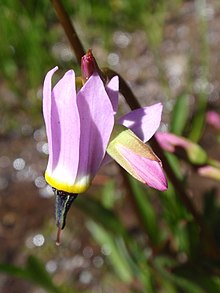
Primula hendersonii is a species of flowering plant in the family Primulaceae, native to western North America, from California north to southern British Columbia and Idaho. Common names include broad-leaved shooting star, Henderson's shooting star, mosquito bills, and sailor caps.

Primula meadia, the shooting star or eastern shooting star, is a species of flowering plant in the primrose family Primulaceae. It is native to the eastern United States and Canada, spanning north from Manitoba and New York, south to Texas and Florida.

Dodecatheon pulchellum, the pretty shooting star, few-flowered shooting star, dark throat shooting star or prairie shooting star, is a species of flowering plant in the primula family Primulaceae.

Polemonium eximium, the skypilot or showy sky pilot, is a perennial plant in the phlox family (Polemoniaceae) that grows at high altitudes. It is endemic to the Sierra Nevada in California where it grows in the talus of the high mountain slopes.

Dodecatheon conjugens, now reclassified as Primula conjugens, is a species of flowering perennial plant in the primrose family, known by the common name Bonneville shooting star.

Dodecatheon jeffreyi is a species of flowering plant in the primrose family known by the common names Sierra shooting star, Jeffrey's shooting star, and tall mountain shooting star. This wildflower is native to western North America from California to Alaska to Montana, where it grows in mountain meadows and streambanks. This is a thick-rooted perennial with long, slightly wrinkled leaves around the base. It erects slim, tall, hairy stems which are dark in color and are topped with inflorescences of 3 to 18 showy flowers. Each flower nods, with its pointed center aimed at the ground when fresh, and becomes more erect with age. It has four or five reflexed sepals in shades of pink, lavender, or white which lie back against the body of the flower. Each sepal base has a blotch of bright yellow. From the corolla mouth protrude large dark anthers surrounding a threadlike stigma. The flowers of this species were considered good luck by the Nlaka'pamux people, who used them as amulets and love charms. Dodecatheon jeffreyi is named in honor of John Jeffrey.

Dodecatheon redolens, sometimes treated synonymously with Primula fragrans, has the common name scented shooting star. It is a species of flowering plant in the primrose family.

Gentianopsis holopetala is a species of flowering plant in the gentian family known by the common names Sierra fringed gentian or just "Sierra gentian"'. It is native to the Sierra Nevada and adjacent mountains in California and Nevada, in wet meadows from 6000 to 11,000 ft in elevation. This is an annual or perennial herb, growing stems which may be anywhere from a few centimeters long to nearly half a meter, and may lay along the ground or grow erect. Its small oval or spoon-shaped leaves are mostly basal but may grow sparsely further along the stem.

Gilia capitata is a species of flowering plant in the phlox family known by the common names blue-thimble-flower, bluehead gilia, blue field gilia, and globe gilia.

Androsace occidentalis is a species of flowering plant in the primrose family known by the common name western rockjasmine.
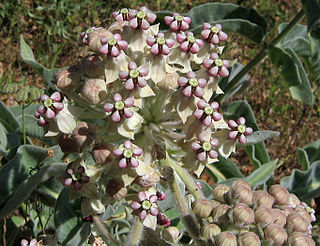
Asclepias eriocarpa is a species of milkweed known by the common names woollypod milkweed, Indian milkweed, and kotolo. It is a perennial herb that grows in many types of habitats.

Calochortus leichtlinii is a species of flowering plant in the lily family known by the common names Leichtlin's mariposa, smokey mariposa, and mariposa lily.

Phlox diffusa is a species of phlox known by the common name spreading phlox. It is native to western North America from British Columbia to the southwestern United States to the Dakotas, where it grows in many types of habitat, including rocky, high elevation mountain slopes. It is a very compact mat-forming perennial herb growing in cushions or patches of short, decumbent stems. The linear, lance-shaped, or needle-like leaves are no more than 1.5 centimeters long and are oppositely arranged in bundles on the short stems. The inflorescence is a solitary tubular flower around a centimeter long. It has a flat white or pale pink or blue corolla with five lobes each just under a centimeter in length.
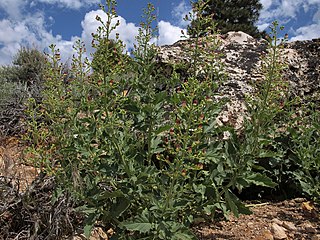
Scrophularia desertorum is a species of flowering plant in the figwort family known by the common name desert figwort. It is native to eastern California and Nevada, where it grows in dry areas in local mountain ranges, including the Sierra Nevada and the desert ranges adjacent. It is a perennial herb producing clusters of erect stems that often exceed one meter tall. The leaves have toothed, triangular or lance-shaped blades up to 13 centimeters long which are borne on petioles measuring up to 10 centimeters in length. The inflorescence is a wide-open panicle with several hairy, glandular branches bearing flowers. The flower has a spherical corolla opening at the top into a hoodlike, lobed mouth. The corolla is just under a centimeter long and is whitish at the base and deep red around the mouth and on the lobes. The staminode is generally visible in the mouth of the corolla. The fruit is a capsule just under a centimeter long containing many seeds.

Scrophularia lanceolata is a species of flowering plant in the figwort family known by the common names lanceleaf figwort and American figwort. It is native to North America, where it is known from western and eastern Canada and much of the United States except for the southeastern quadrant. Past common names include Western figwort when the western US plants were grouped under the name Scrophularia occidentalis and the eastern US plants were called Scrophularia leporella with the common name hare figwort.
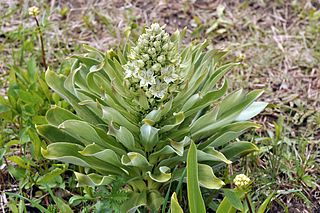
Frasera speciosa is a species of flowering plant in the gentian family (Gentianaceae) known by the common names elkweed, deer's ears, and monument plant.

Triteleia montana is a monocot flowering plant in the genus Triteleia. Its common names include Sierra triteleia, and mountain triteleia. It is endemic to California, where it is limited to the Sierra Nevada. It occurs in coniferous forests on granite soils. The Latin specific epithet montana refers to mountains or coming from mountains. It is a perennial wildflower growing from a corm. There are two or three basal leaves measuring up to 30 centimeters long and just a few millimeters wide. The inflorescence arises on an erect, rough-haired stem up to 25 or 30 centimeters tall. It is an umbel-like cluster of several flowers each borne on a pedicel up to 3 centimeters long. The flower is yellow with a dark midvein, and dries purplish. The funnel-shaped corolla is made up of six tepals up to a centimeter long each. There are six stamens with white or blue anthers.
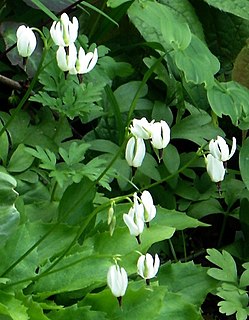
Dodecatheon dentatum is a species of flowering plant in the family Primulaceae, known by the common names white shooting star and toothed American cowslip.
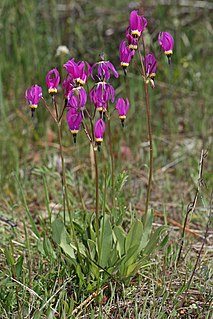
Dodecatheon poeticum is commonly known as the poet's shooting star or the Narcissus shooting star. D. poeticum is a species of the genus Dodecatheon which is native to the states of Oregon and Washington in western North America. The genus Dodecatheon contains herbaceous flowering plants and is also a part of the primrose family Primulaceae. This plant has basal clumps of leaves and drooping flowers that occur at the apex of tall stems that rise from where the leaves join.

The flora of the U.S. Sierra Nevada alpine zone is characterized by small, low growing, cushion and mat forming plants that can survive the harsh conditions in the high-altitude alpine zone above the timber line. These flora often occur in alpine fell-fields. The Sierra Nevada alpine zone lacks a dominant plant species that characterizes it, so may or may not be called a vegetation type. But it is found above the subalpine forest, which is the highest in a succession of recognized vegetation types at increasing elevations.
